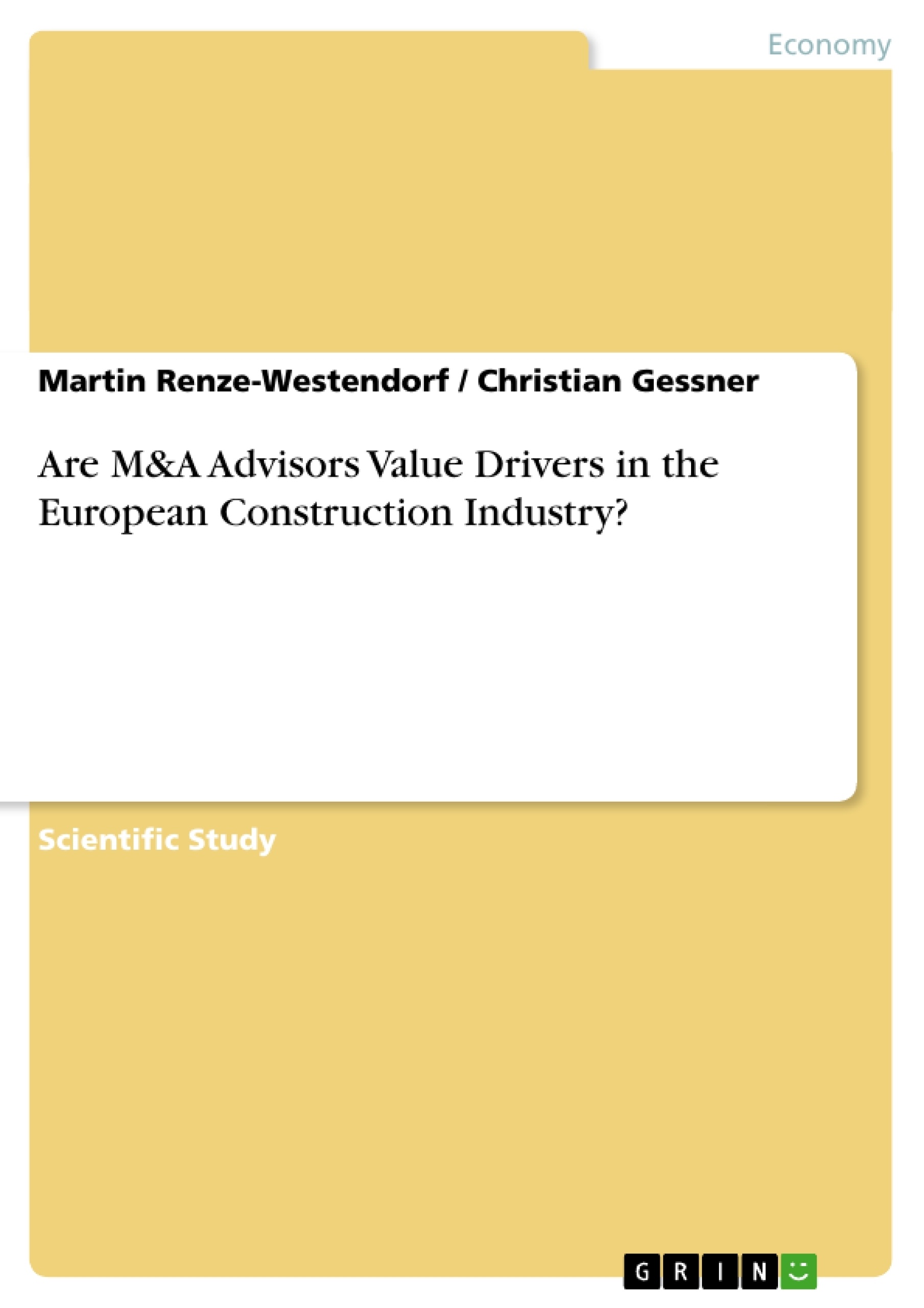Over the last decade, there is an increasing involvement of financial advisers in European M&A-transactions. Since 1995 the involvement of M&A-advisers in transactions with European participation has more than doubled (16.4% in 1995; 34.7% in 2005). In approximately a quarter of all deals (mean percentage of deals from 1995-2005), M&A-advisers were involved. This raises the questions whether companies hiring M&A-advisers are better off and whether M&A-advisers can be seen as value drivers. The aforementioned questions have been rarely examined in empirical research. Furthermore, most of the existing studies focus on the US-American M&A-market. There has been little research on the European M&A-market and no research at all on the European construction industry in particular. Thus, the paper’s purpose is to examine the question whether M&A-advisers are value drivers in the European construction industry. In the first part of this paper relevant theoretical concepts (2.1) are presented, existing literature is reviewed (2.2) and the research hypotheses are derived from theory (2.3). In the empirical part of the paper, the selection of the data sample (3.1) and the event study methodology (3.2) are first described. Then, the four hypotheses (adviser involvement, adviser reputation, negotiation effect and number of adviser involved) are tested followed by the multivariate analysis and the combined entity analysis (3.3). The paper is concluded by a summary of the findings including implications for further research (4).
Inhaltsverzeichnis (Table of Contents)
- INTRODUCTION
- THEORETICAL CONCEPTS AND LITERATURE REVIEW
- THEORETICAL CONCEPTS
- LITERATURE REVIEW
- RESEARCH HYPOTHESES
- M&A-ADVISERS IN THE EUROPEAN CONSTRUCTION INDUSTRY: EMPIRICAL EVIDENCE
- DATA SAMPLE - SELECTION AND DESCRIPTION
- EVENT STUDY METHODOLOGY
- EMPIRICAL EVIDENCE FROM THE EUROPEAN CONSTRUCTION INDUSTRY
- Hypothesis 1: Adviser Effect
- Hypothesis 2: Reputation Effect
- Hypothesis 3: Negotiation Effect
- Hypothesis 4: Number of Adviser Involved
- Multivariate Analysis
- Combined Entity Analysis
- SUMMARY AND CONCLUSION
Zielsetzung und Themenschwerpunkte (Objectives and Key Themes)
This research paper aims to investigate whether M&A-advisers are value drivers in the European construction industry. This objective is achieved through empirical research focusing on the impact of M&A-advisers on transaction success, measured by the cumulative abnormal return (CAR) of shareholders. The study analyzes data from the European construction industry, specifically addressing the lack of existing research on this sector. The paper utilizes a theoretical framework and literature review to establish research hypotheses, which are then tested using event study methodology and multivariate analysis. The findings aim to contribute to understanding the role of M&A-advisers in value creation within the European construction industry.
- The role of M&A-advisers in value creation within the European construction industry.
- The impact of M&A-advisers on transaction success, measured by cumulative abnormal return (CAR).
- The influence of factors such as adviser effect, reputation effect, negotiation effect, and number of advisers involved on transaction outcomes.
- Analysis of the European construction industry, addressing the gap in existing research.
- Utilization of theoretical framework, literature review, event study methodology, and multivariate analysis to test research hypotheses.
Zusammenfassung der Kapitel (Chapter Summaries)
The paper starts with an introduction outlining the research question and its relevance in the context of increasing M&A-adviser involvement in European transactions. It then delves into the theoretical framework (Chapter 2.1), providing insights into the prominence of investment banks in M&A-transactions. The literature review (Chapter 2.2) examines existing research on the value impact of M&A-advisers, highlighting the limited evidence for the European construction industry. Building on this theoretical foundation, Chapter 2.3 formulates research hypotheses focusing on the impact of adviser involvement, reputation, negotiation skills, and the number of advisers on transaction outcomes. The empirical part of the paper (Chapter 3) focuses on the data sample selection and description (Chapter 3.1), followed by an explanation of the event study methodology employed (Chapter 3.2). Chapter 3.3 presents the empirical evidence from the European construction industry, analyzing each hypothesis individually and then collectively through multivariate analysis and combined entity analysis.
Schlüsselwörter (Keywords)
The research revolves around the impact of M&A-advisers on value creation in the European construction industry. Key concepts explored include cumulative abnormal return (CAR) as a measure of transaction success, event study methodology for analyzing market reaction to transactions, and factors such as adviser effect, reputation effect, negotiation effect, and the number of advisers involved. The study focuses on the European construction industry, aiming to fill the gap in existing research on this sector. Key terms like M&A-advisers, value drivers, European construction industry, transaction success, cumulative abnormal return, event study methodology, and multivariate analysis are central to the research.
- Arbeit zitieren
- Martin Renze-Westendorf (Autor:in), Christian Gessner (Autor:in), 2006, Are M&A Advisors Value Drivers in the European Construction Industry?, München, GRIN Verlag, https://www.grin.com/document/58642



